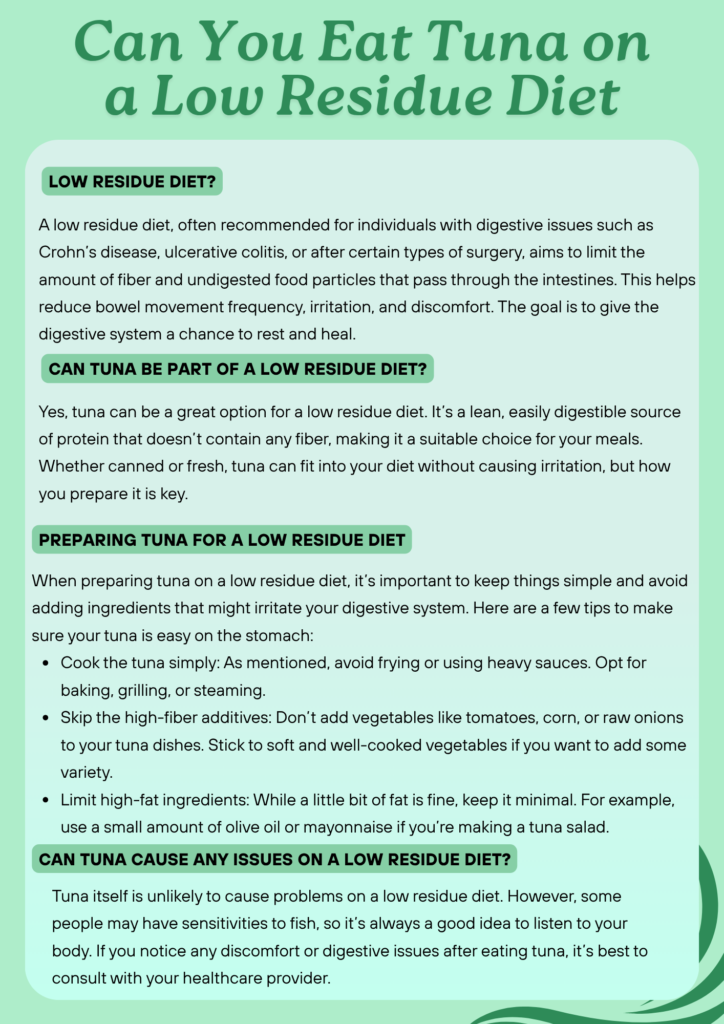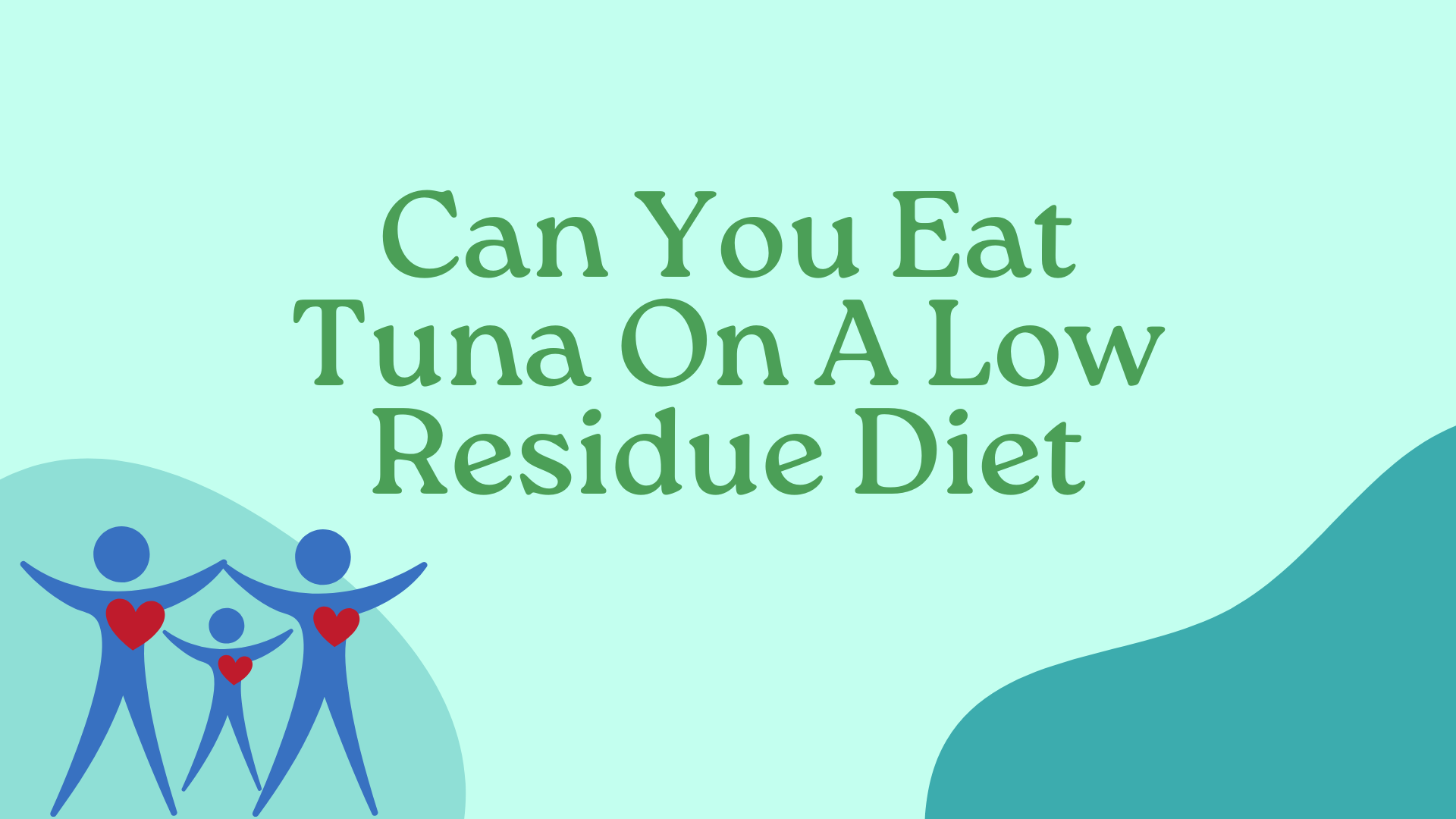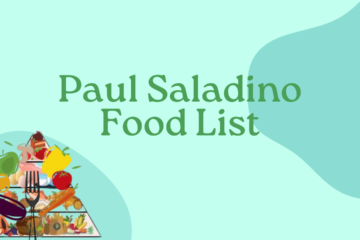If you’re following a low residue diet, you might be wondering if tuna, a popular and nutritious fish, fits into your meal plan. The short answer is yes, but with a few considerations. Let’s break it down and explore how tuna can work for your low residue diet, along with some tips for making the most of your meals during this dietary phase.
Table of Contents
What Is a Low Residue Diet?
A low residue diet, often recommended for individuals with digestive issues such as Crohn’s disease, ulcerative colitis, or after certain types of surgery, aims to limit the amount of fiber and undigested food particles that pass through the intestines. This helps reduce bowel movement frequency, irritation, and discomfort. The goal is to give the digestive system a chance to rest and heal.
On a low residue diet, foods that are easy to digest and produce minimal waste are encouraged. This typically means avoiding high-fiber foods like whole grains, raw vegetables, and nuts, while focusing on easily digestible proteins, white bread, and cooked vegetables.

Can Tuna Be Part of a Low Residue Diet?
Yes, tuna can be a great option for a low residue diet. It’s a lean, easily digestible source of protein that doesn’t contain any fiber, making it a suitable choice for your meals. Whether canned or fresh, tuna can fit into your diet without causing irritation, but how you prepare it is key.
Fresh Tuna
Fresh tuna, such as grilled or baked tuna steak, is a soft, high-protein option for a low residue diet. Just make sure you prepare it simply—avoid adding spicy sauces, excess seasoning, or vegetables that may be harder to digest. Stick to gentle cooking methods like grilling, baking, or steaming to keep it light.
Canned Tuna
Canned tuna is another excellent choice for a low residue diet. It’s convenient, affordable, and easy to prepare. Look for tuna packed in water, as it tends to be lower in fat than tuna packed in oil. You can mix it with a small amount of mayonnaise or plain yogurt for a simple tuna salad. Just remember to avoid adding crunchy vegetables like celery or onions, as they may be harder to digest.
Preparing Tuna for a Low Residue Diet
When preparing tuna on a low residue diet, it’s important to keep things simple and avoid adding ingredients that might irritate your digestive system. Here are a few tips to make sure your tuna is easy on the stomach:
- Cook the tuna simply: As mentioned, avoid frying or using heavy sauces. Opt for baking, grilling, or steaming.
- Skip the high-fiber additives: Don’t add vegetables like tomatoes, corn, or raw onions to your tuna dishes. Stick to soft and well-cooked vegetables if you want to add some variety.
- Limit high-fat ingredients: While a little bit of fat is fine, keep it minimal. For example, use a small amount of olive oil or mayonnaise if you’re making a tuna salad.
Other Protein Options for a Low Residue Diet
If you’re looking to mix up your protein sources, here are a few other options that are easy to digest and low in residue:
- Chicken: Skinless chicken breast, grilled or baked, is a lean and easy-to-digest source of protein.
- Eggs: Scrambled or poached eggs are soft and easy on the stomach.
- Fish: Besides tuna, other fish like salmon, cod, and tilapia are also good choices. Just make sure to prepare them in simple ways, avoiding heavy sauces or seasonings.
- Tofu: If you’re looking for a plant-based option, tofu can be a good choice, as long as it’s soft and not fried.
Can Tuna Cause Any Issues on a Low Residue Diet?
Tuna itself is unlikely to cause problems on a low residue diet. However, some people may have sensitivities to fish, so it’s always a good idea to listen to your body. If you notice any discomfort or digestive issues after eating tuna, it’s best to consult with your healthcare provider.
Also, be mindful of the sodium content in canned tuna. Some varieties can be quite high in sodium, so it’s a good idea to look for low-sodium options to prevent any potential issues with bloating or high blood pressure.
Final Thoughts
Tuna can absolutely be part of a low residue diet, as it’s a lean, easily digestible source of protein that doesn’t contain fiber. Whether you choose fresh tuna steaks or canned tuna, you can enjoy it in moderation while keeping your meals light and easy on the stomach. Just remember to prepare it simply and avoid high-fiber or high-fat ingredients that could cause digestive discomfort.
If you’re ever in doubt about your diet or have specific dietary restrictions, always consult with your healthcare provider to ensure your meal plan supports your health and recovery goals.




